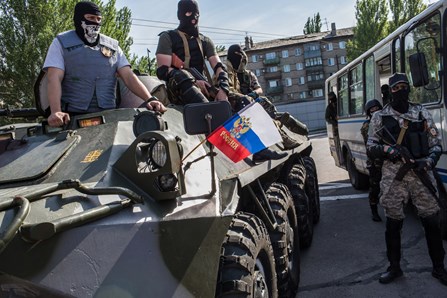
Understanding the Mysterious Appearance of the Chechen ‘Vostok’ Battalion in Eastern Ukraine
Publication: Eurasia Daily Monitor Volume: 11 Issue: 101
By:

Chechens confirm their brand worldwide every year. Unfortunately, it is not a brand of high fashion, or new direction in art or science. Chechens are regularly depicted as the bad guys prepared to fight anywhere in the world. The theme of the Russian mafia in Hollywood movies has given way to the Chechen mafia and Chechen jihadists—a Chechen criminal world that threatens American interests around the globe (https://www.militaryparitet.com/perevodnie/data/ic_perevodnie/2256/).
Chechens have also surfaced in the Russian-Ukrainian conflict. News agencies have provided links to video reports purporting to show the presence of Chechens among the unidentified armed groups in eastern Ukraine. Sometimes, the uninformed opinion of a lay person looking outside from his car (https://www.youtube.com/watch?v=mAPe02IXBQI) is considered sufficient to figure out that the Chechens are kadyrovtsy, meaning those Chechens who are loyalists of Ramzan Kadyrov, the authoritarian Moscow-backed Chechen leader.
The spokesman for the Ukrainian anti-terrorist operation, Vladislav Seleznev, confirmed that people of Caucasian appearance are among the militants fighting in eastern Ukraine. “We have operative information about many people of Caucasian appearance among the militants” (https://www.ukrinform.ua/rus/news/na_donbasse_deystvuyut_kavkaztsi___seleznev_1637090). One of the videos shows a person who states on camera that he and the other armed men around him are Chechens, Afghans, Muslims who came to eastern Ukraine “to protect Russia, to protect Russians and to protect the interests of this country” (https://inforesist.org/video-batalon-vostok-daet-intervyu/).
The clearest apparent confirmation of the presence of Chechens in the conflict came in a CNN report in Donetsk. Two people replied to the reporter’s question that they were from Chechnya and were kadyrovtsy. They refused to say what unit they were from, but nodded affirmatively when the reporter suggested that they were with the Russian interior ministry (https://www.youtube.com/watch?v=RAAqqBIRxIY).
However, it was not immediately clear from the report if the Chechens were dispatched to Ukraine by the Russian authorities. An armored personnel carrier (APC) carrying the armed men bore the inscription “Battalion Vostok” in large script to make sure it was visible to everyone. The Vostok battalion was disbanded on November 8, 2008, almost immediately after the war in Georgia. As Interfax reported at the time: “The battalions Vostok and Zapad of the 42nd Motorized Rifle Division of the Ministry of Defense of Russia were disbanded,” the deputy commander of Russian Defense Ministry’s ground forces, Colonel-General Vladimir Moltenskoi, told Ramzan Kadyrov in a face-to-face meeting (https://www.interfax.ru/44317).
Those who like to point to the Vostok battalion should understand that the battalion was led by Ramzan Kadyrov’s worst enemy, Sulim Yamadaev. So Kadyrov would not have allowed his people, the kadyrovtsy, to use the name of the battalion of his former nemesis. Another indicator that the group may not have ties to Kadyrov is the fact that fighters from the so-called Vostok battalion openly smoked in front of cameras—something which would be highly improbable, to put it mildly, in Kadyrov’s units because it is haram (forbidden) in Islam and the Chechen strongman, at least in public, tries to have his subordinates maintain the appearance of being good Muslims (https://argumentua.com/stati/donetsk-posle-vyborov-kadyrovskaya-svoloch-est-vlasti-net).
It is more likely that the Donetsk separatists set up their own version of the “Vostok” battalion that has nothing to do with the original Chechen battalion. The well-known analyst Oleg Kashin pointed out that Chechens once served as bodyguards for Ukraine’s richest businessmen, Renat Akhmetov. According to Kashin, there are Chechens, Ossetians and members of other ethnic groups active in eastern Ukraine (https://kashin.guru/2014/05/25/checehn/).
Various news agencies reported that dozens of Chechens were among the victims of the fighting at Donetsk airport on May 26–27 (https://newsdaily.com.ua/post/263109). However, Donetsk’s mayor said only eight Russian were killed, including three Chechens. None of their surnames, however, are even vaguely Chechen except for one—that of Murat Lamalievich Dadaev, who might have been a Chechen (https://www.segodnia.ru/content/140108). Ukrainian media showed the passport of a Chechen who was born in Grozny, but the passport’s owner turned out to have been an ethnic Russian, Alexander Petrovich Yurtaev, who, according to his passport, was born in Grozny but resided in Stavropol region (https://twitter.com/novostidnua/status/471408146897199104/photo/1).
Ramzan Kadyrov responded to the multiple allegations about the participation of kadyrovtsy on the pro-Russian side of the conflict, saying that no “Chechen servicemen” or “military convoys of Chechnya” were taking part in the conflict (https://instagram.com/p/ohIgWPiRoG/). The story is so convoluted that all of the claims on all sides are highly dubious. The less transparent the story is, the more likely it is that the government in Kyiv will make a mistake; and any misstep on Kyiv’s part will play into Moscow’s hands.
Given the evidence discussed above, one can safely assume that there are Chechens in Ukraine, as well as members other ethnic groups from Russia. The total number of Chechens probably does not likely exceed 100. It is not so important how many of them there are. The fact that the Russian authorities refused to admit there are any Chechens fighting in Ukraine suggests they may have been framed. The same thing happened in 1994, in the run up to the first Russian-Chechen war, when the Russian army officially refused to admit that it had sent soldiers and officers to conduct a special operation in Chechnya.
The presence of Chechens in Ukraine is likely to be connected to certain politicians. Were such connections revealed, they would also expose the Kremlin’s plans for eastern Ukraine in the near future.




